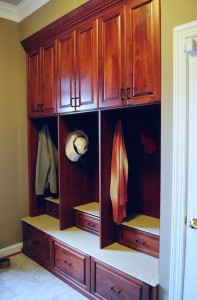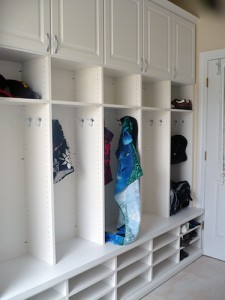Schedule a Free Consult
Schedule Your
Free Design Consultation
Free Design Consultation
Mudrooms are a catchall for the daily things that we use in our lives and when designed properly, a mudroom can be a productive, user-friendly space for storage. And, it’s a space that helps to keep the rest of your floors clean while acting as a barrier between your home and the outside world.
When designing a mud room, you must determine the most effective location for your family’s needs. The best place to put a mudroom is near whichever door that everyone most often enters. For some families it’s the front door, but for others it can be the kitchen, back entrance, garage or through a utility room.
Once your location is set, determine how much space you have to create the mudroom. It doesn’t necessarily need to be an entire room; it can be a small area or simply a wall. If your mud room is near the main entrance of the house, then you’ll want to design it to resemble the style of your house. Remember, guests will see the mudroom, so you want it to be an attractive and organized space. Consider investing in custom mudroom cabinets and shelving, which you can match to the rest of your home’s décor.

If your mudroom is going to be located near the garage, the best organization systems for this space are garage storage systems that are built to withstand lots of wear and tear. Custom garage cabinet systems would work well in this type of mudroom since this is a heavily trafficked area and will most likely be an offshoot of the garage. Chances are, you’ll need a more rugged storage solution since this is where you’ll put heavy weather shoes, clothing and maybe even small sports equipment.
Here are four great tips to keep in mind when designing your mudroom:
1 – Plan for Function and Need
Design your mudroom so that it’s an organizational system that incorporates your family’s quick storage needs. Add up how many people will use the room and what will be put in the space. Kids will need a place to hang their backpacks while adults need room for briefcases and purses. Think about other things you will want to store here like pet leashes or rain boots, too.
2 – Sort and Categorize Your Mudroom Items
Go through the items you think you want to store in the mud room. Then, sort them in four categories: keep, sell, toss and donate. The keep items are what the mudroom should be designed to store. This exercise helps to eliminate all the extraneous stuff you want to put in the mudroom because you have no other place for them. Don’t forget, your mudroom is only for quick retrieval and unloading items, this is not the place for long-term storage.
 3 – Get the Right Storage Solutions
3 – Get the Right Storage Solutions
Depending on your space and needs, you may simply need a one-wall organizer system with some hooks and baskets, or a custom storage system that will have built in organizational features like cabinets, adjustable shoe racks, shelves and storage bins. Keep in mind, your family’s current needs and flexible options can change as their needs change. If you have young kids, their needs will grow as they grow. Whenever possible, always choose storage solutions with adjustable features.
4 – Keep It Simple
Don’t have an overly complicated system or too many places for all the things your family carries in and out of the house because they won’t use all the storage solutions you’ve created. Make sure everyone in the family knows what goes where, and sticks to the plan in order to effectively use the mudroom. Experts also suggest in order to keep clutter down in other parts of the house, put a bin in the mudroom where you keep new purchases until you can decide where they go.
Each of our custom systems is completely personalized and begins with a complimentary design appointment.
Schedule a ConsultDuring the consultation you and a designer will discuss goals, desires, and project budget, with the aim of designing an organization system that will: